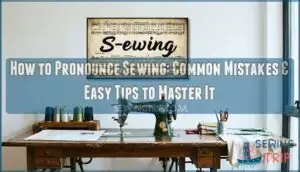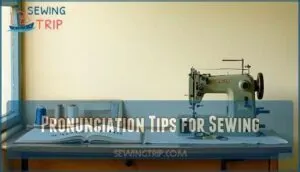This site is supported by our readers. We may earn a commission, at no cost to you, if you purchase through links.

The word rhymes with "going" and "showing" – think of it as "SO" plus "ING."
This trips up many people because we expect the "ew" to sound like "oo" as it does in words like "few" or "crew." But sewing breaks that rule completely.
The pronunciation comes from the base verb "sew," which has always used the long O sound.
Master this quirky pronunciation and you’ll sound confident discussing this popular craft.
There’s actually more to getting each sound just right.
Table Of Contents
Key Takeaways
- You’ll pronounce "sewing" as "SO-ing" – it rhymes with "going" and "showing," not "SOO-ing" like you’d expect from the spelling
- The ‘w’ stays completely silent – this comes from Old English "siwian" where the ‘w’ wasn’t pronounced, and modern English kept this pattern
- You’ll avoid the most common mistake – don’t say "SOO-ing" like "chewing" or "viewing," which trips up many speakers due to similar letter patterns
- You can practice with rhyming words – use "flowing," "glowing," and "showing" to nail the correct long O sound and build confidence in craft conversations
How to Pronounce Sewing
Most people pronounce "sewing" as SO-ing, where the first syllable sounds like "so" in "nose" and ends with "ing" like "sing." The sewing pronunciation follows standard English Speech Patterns with emphasis on the first syllable.
UK pronunciation uses the /əʊ/ diphthong while US pronunciation features /oʊ/. This phonetic transcription shows Dialect Differences between regions.
Understanding these Accent Influence variations helps master proper pronunciation. Language Evolution has kept the core sounds consistent across English-speaking areas.
Whether you’re learning Sewing Basics or discussing techniques, this pronunciation guide guarantees clear communication about your craft.
Common Mispronunciations of Sewing
Everyone makes sewing errors when first learning this word.
The most common pronunciation difficulties stem from treating "sewing" like "chewing" or "viewing."
Many speakers incorrectly say "SOO-ing" instead of the proper "SOH-ing."
This phonetic mistake happens because English spelling doesn’t match pronunciation here.
Accent issues create regional variations too.
Some American dialects produce "SAW-ing" while others attempt "SEW-wing" with emphasis on both syllables.
The silent w causes major dialect problems for non-native speakers who apply phonetic rules literally.
International learners face unique pronunciation difficulties.
Spanish speakers often say "SEH-ing" while Japanese learners might produce "SEH-o-ing" due to unfamiliar diphthongs.
Russian speakers frequently replace the w sound with v, creating "SEH-ving."
Remember: the correct pronunciation uses a long O sound like "toe" plus "ing".
The w stays completely silent.
Practice makes perfect with these common mispronunciations.
The key to improving pronunciation is to focus on the correct pronunciation and to practice regularly.
By doing so, learners can overcome the common mispronunciations and develop a more accurate pronunciation of the word "sewing".
Pronunciation Tips for Sewing
Now you can tackle the tricky sounds that make up "sewing" one by one. Breaking down each sound helps you master the correct pronunciation and avoid common mistakes.
Pronouncing The S Sound
The /s/ sound in "sewing" acts like a snake’s hiss.
Position your tongue tip near your upper teeth without touching.
Keep your vocal cords relaxed and push air through the narrow gap.
This unvoiced consonant requires steady airflow for clear articulation.
Practice with S Sound Tips by repeating "sa-se-si-so" slowly.
Many learners struggle with this phoneme, but consistent practice improves your sewing pronunciation and overall English pronunciation skills.
To master the /s/ sound, focus on proper tongue position techniques for ideal results, which leads to better pronunciation.
Pronouncing The E Sound
After mastering the initial ‘s’, your mouth naturally moves to form the ‘e’ sound in sewing.
Your mouth effortlessly flows from the crisp ‘s’ to the elongated ‘e’ sound, setting up perfect sewing pronunciation.
This vowel formation creates a long ‘e’ as in "see."
Your tongue stays high and forward while your lips remain slightly spread.
E sound variations depend on accent influence and regional patterns.
Focus on clear articulation – avoid rushing this phonetic step.
The diphthong analysis shows this connects smoothly to the following sounds, making proper English pronunciation flow naturally with consistent phonetic rules.
Understanding proper sewing pronunciation techniques is essential for effective communication.
Pronouncing The W Sound
The W sound in "sewing" tricks many English speakers because it stays silent. Your lips should form a gentle pucker like you’re about to whistle, but don’t make the actual W sound. This lip movement helps shift smoothly from the long E to the short I sound.
- Silent W Rule – The W remains completely quiet in sewing phonetics
- Lip Movement – Round your lips briefly without producing sound
- Articulation Techniques – Practice the lip shape with other silent W words
- W Pronunciation – Focus on the lip position rather than the sound itself
Understanding silent W rules can help improve overall pronunciation.
Pronouncing The I Sound
After handling the ‘w’ sound, you’ll tackle the short ‘i’ vowel in sewing’s second syllable.
This i sound matches the vowel in "ship" or "tip" – it’s brief and crisp.
Your tongue sits in a neutral position while your lips stay relaxed.
The phonetic analysis shows /ɪ/ requires precise vowel pronunciation.
Many speakers accidentally lengthen this sound, but accent modification training emphasizes keeping it short.
Sound distinctions matter here – avoid the long ‘ee’ sound.
Practice phonetics by repeating "sit-sewing" to nail this language pronunciation element, focusing on the short ‘i’ sound.
Pronouncing The Ng Sound
The final ng sound in "sewing" trips up many speakers.
This nasal consonant forms when your tongue touches the soft palate at the back of your mouth. Air flows through your nose while your vocal cords vibrate.
Here’s your Articulation Guide for mastering this ng sound:
- Sound Formation: Press your tongue’s back against your soft palate
- Nasal Consonants: Let air flow through your nose, not your mouth
- Pronunciation Practice: Say "sing" without adding a hard "g" sound
- Ng Sound Tips: Keep your mouth relaxed and avoid tongue release
Practice with phonetic symbols /ŋ/ to nail this tricky sound every time. Mastering the Pronunciation Guides is essential for improving overall speech clarity.
Pronunciation Variations Across Different English-speaking Regions
Once you’ve mastered the basic sounds, you’ll notice pronunciation variations across different English-speaking regions.
These regional accents create fascinating dialect differences that showcase our language diversity.
American speakers typically use /ˈsoʊ.ɪŋ/ with a clear diphthong.
British English features /ˈsəʊ.ɪŋ/ with different vowel sounds.
Canadian pronunciation mirrors American patterns, while Australian English uses /ˈsəʉ.ɪŋ/ with its unique diphthong.
These English varieties reflect accent evolution over centuries:
- Southern American dialects may draw out vowels and drop the final "g" sound
- British regional accents like Northern English modify the first syllable vowel substantially
- Caribbean English adds rhythmic stress patterns between syllables
Pronunciation trends show these dialect differences aren’t mistakes – they’re natural language diversity.
Each region’s accent tells a story of cultural heritage.
Whether you say it with a crisp British clip or relaxed American drawl, you’re connecting with sewing traditions worldwide.
Understanding the historical language evolution patterns helps explain why sewing is pronounced differently across regions.
Frequently Asked Questions (FAQs)
How do you pronounce ‘sewing’?
Ever wonder why this crafting term trips people up?
You pronounce "sewing" as SO-ing, with the first syllable sounding like "so" and the second like "ing."
The ‘w’ stays silent, making it rhyme with "flowing" or "going", which is a key concept to understand the pronunciation.
How is the word ‘sewer’ pronounced?
Sewer" has two pronunciations depending on meaning.
You’ll say "SOO-er" (/ˈsuːər/) when referring to someone who sews fabric.
You’ll say "SOO-wer" (/ˈsuːwər/) when talking about underground drainage systems.
How do you pronounce sewn?
Like threading a needle with precision, you’ll pronounce "sewn" as /soʊn/ – rhyming with "tone" or "phone."
The ‘w’ stays silent.
Simply say "sohn" with that long ‘o’ sound flowing smoothly into the final ‘n’.
What does sew mean in English?
Sew means to join pieces of fabric or material using a needle and thread.
You create stitches that hold things together.
In English, you’ll use “sew” when talking about making or repairing clothes and crafts.
How do you pronounce sow & sew?
You pronounce "sow" with the /aʊ/ sound like "cow" when planting seeds.
"Sew" uses the /oʊ/ diphthong like "so."
The key difference lies in these vowel sounds distinguishing their meanings completely.
How do you use the verb ‘sew’ in a sentence?
Did you know “sew” appears about 37 times per million English words?
When you use it, say, “You sew a button onto your shirt.”
This verb means joining fabric with a needle and thread.
Which one is correct, sowing or sewing?
Sewing" is correct when you’re talking about stitching fabric together. "Sowing" means planting seeds in soil. You’d say "I’m sewing a dress" or "The farmer is sowing wheat seeds.
How do you pronounce sewing and sawing?
While you might think these words sound similar, they’re pronounced quite differently.
"Sewing" sounds like "SO-ing" with a long O sound, while "sawing" rhymes with "lawing" using an "aw" sound like "saw".
Does sewing rhyme with showing or glowing?
Yes, "sewing" rhymes with "showing" and "glowing."
You’ll pronounce it as /ˈsoʊɪŋ/ – the "ew" creates that long "oh" sound, not "oo."
Think "SO-ing" with emphasis on the first syllable, matching the vowel pattern in both rhyming words perfectly.
Why is the w silent in sewing?
Though you’d expect all letters in "sewing" to sound out, the ‘w’ stays silent due to historical language evolution.
The word comes from Old English "siwian," where the ‘w’ wasn’t pronounced, and modern English preserved this traditional pronunciation pattern.
Conclusion
Perfect practice makes perfect pronunciation. Consistent effort creates confident communication. Clear speech builds better understanding.
Now you know how do we pronounce sewing correctly. Remember the long O sound like "SO-ing."
Practice with words that rhyme like going and showing. Avoid the "SOO-ing" trap that catches many speakers.
The base verb "sew" guides the pronunciation. Keep practicing these phonetic patterns. Your speech will improve with regular repetition.
Master this quirky word and boost your confidence in craft conversations, with clear speech.







